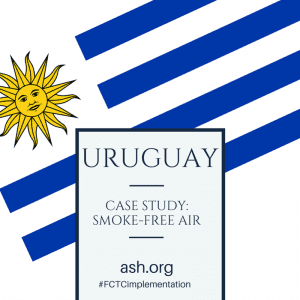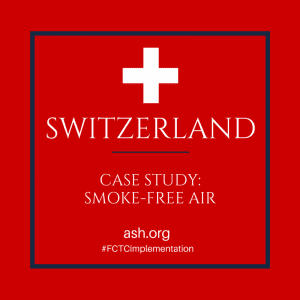Many Americans view smoking, and secondhand smoke, as a problem that has mostly been solved, at least in the United States.
However, only half of all Americans are protected from exposure to secondhand smoke, whether in public places or at work.
Several countries around the world have achieved complete protection for their citizens. With support from the Robert Wood Johnson Foundation, ASH has written case studies on two of these success stories: France, Uruguay. Now we add a third, Switzerland, which presents a more mixed result in a federal system similar to the U.S.
ASH’s case studies are meant to help illustrate how these countries addressed the problem of secondhand smoke and to help provide guidance to countries that are still working toward complete protection for their citizens.
FRANCE
Many people thought smoke-free air in France was impossible. The very image of France was of people eating, drinking, and smoking in outdoor cafes. Smoking was glamourized and thought to be inextricably linked to French culture. However, now France has a comprehensive smoke-free air law. Here are some of the primary lessons learned from the fight for smoke-free air in France. 
- If at first you don’t succeed, try again
- France tried to implement a law that included smoke-free air as early as 1991. However, the law was vague and poorly enforced. When the new smoke-free laws were written, the drafters were careful to avoid these same mistakes, and the new law was much stronger.
- Use litigation as a tool for public health
- Litigation was strategically used to enforce France’s original smoke-free law, in order to raise public awareness and to press for stronger enforcement. Private litigation also raised the profile of this issue.
Of course, smoke-free air in France was much more complicated than these two lessons. To read more about the path to smoke-free air in France, read our case study here>
URUGUAY
Smoking, and secondhand smoke, continues to be a growing problem in Latin America. In the early 2000s, a study in seven Latin American countries found second-hand smoke in 94% of the public locations surveyed, including not only in bars and restaurants but also in schools, government buildings, and other places where smoking was prohibited by law. Read more here>. However, Uruguay has managed to buck the trend and create a very comprehensive smoke-free air law. Here are some of the lessons to learn from Uruguay. 
- Utilize the Framework Convention on Tobacco Control (FCTC)
- The FCTC is based on science and best practice, and it is backed by the WHO, the world’s leading health authority. As a small country, Uruguay found the FCTC invaluable as a tool to convince policymakers and civil society of both the need for tobacco regulations and the efficacy of the proposed interventions. Uruguay did not need to “reinvent the whee.” The FCTC already provided ample evidence of the effectiveness of nearly all potential tobacco control measures.
- Fight tobacco, not smokers
- Uruguay involved nearly a third of its population in the “Thanks a Million” campaign, which garnered 1 million signatures to thank the roughly 1 million smokers for compliance with smoke-free rules. Due to that campaign, smokers were more willing to comply with “no smoking” signs, because they felt that those efforts were appreciated. This campaign went a long way toward assuring public acceptance of tobacco control measures.
To read more about smoke-free air in Uruguay, see our case study here>.
SWITZERLAND
Switzerland has been working toward smoke-free public places for many years. Because of the federal system in the country, local laws were passed long before the national law. Smoke-free legislation in Switzerland has been subjected to several legal challenges by tobacco companies. Due to the slow legislative process at the cantonal level, weak national legislation, and opposition from the tobacco industry, Switzerland as a whole has a substantial amount of work left to do. However, many cantons (a jurisdiction similar to a U.S. state) have made great strides towards protecting their citizens from the harms of secondhand smoke. Here are some the lessons learned from the fight for smoke-free air in Switzerland. 
- Use the democratic system to your advantage
- In Switzerland, as in many other countries, localities have the right to pass their own laws. By passing local smoke-free air laws, individual cantons drove the national government to create a federal law on the topic.
- Once there is a model in a jurisdiction, target new jurisdictions that view themselves as similar
- In a country with multiple jurisdictions, each jurisdiction views itself as more kindred with some neighbors than others. In the U.S., Nebraska is more likely to look to Kansas than to New York. In Switzerland, all of the French speaking cantons passed smoke-free air laws, based on a model from Geneva, another French-speaking canton.
To read more about smoke-free air in Switzerland, read the full case study here>.
To read more about tobacco control best practices around the world and how they can be implemented in the United States, please see ASH’s FCTC Implementation Guide>.








